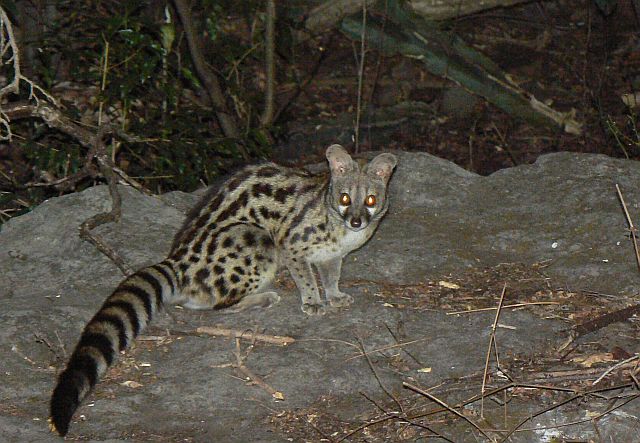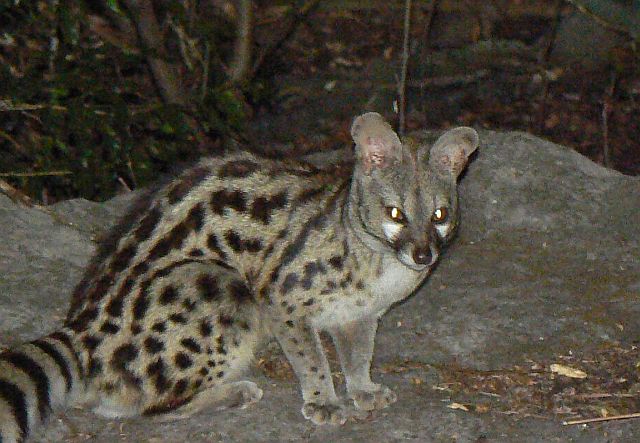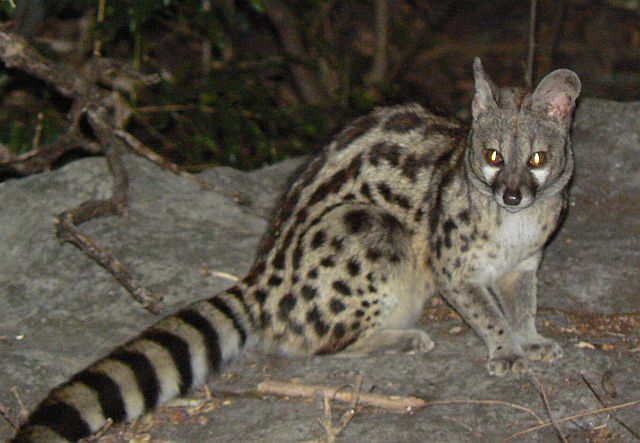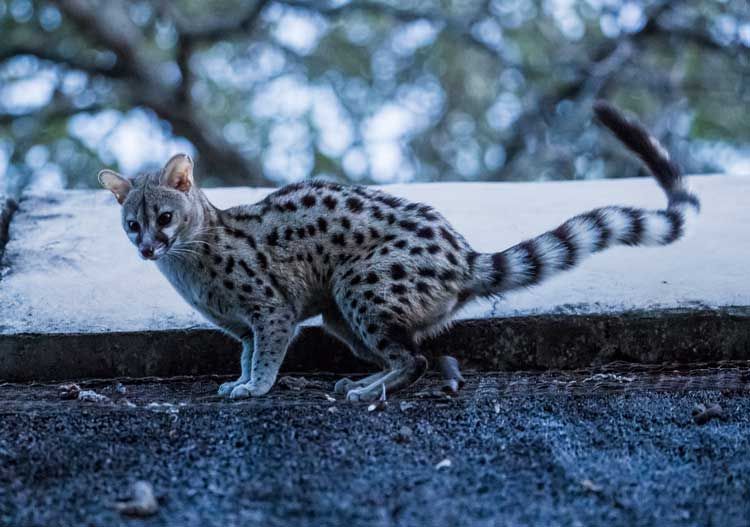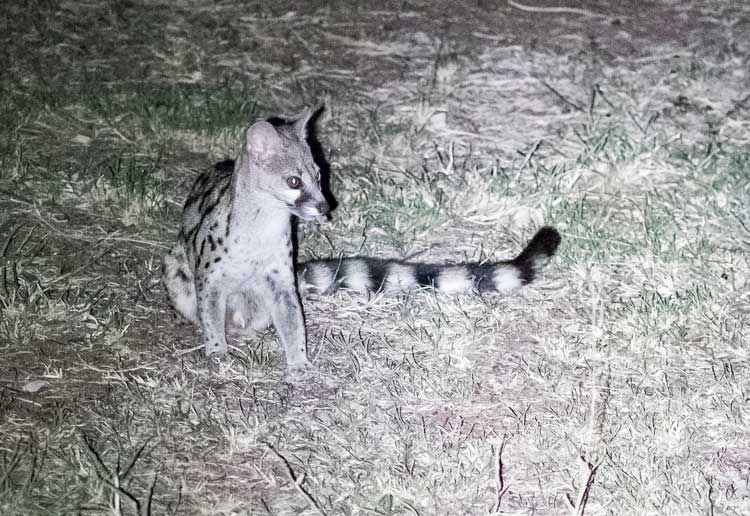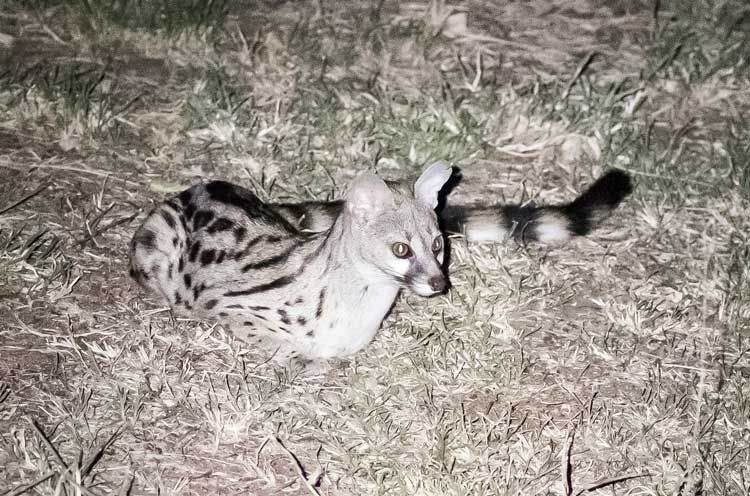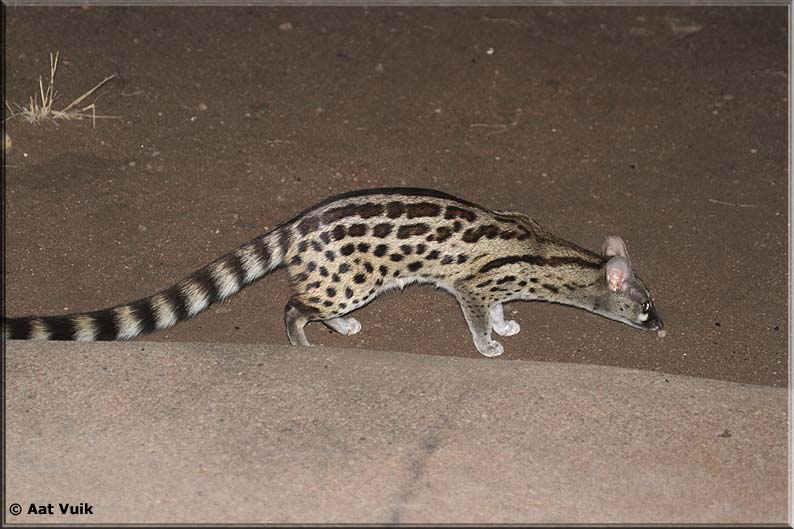Genets (Genetta spp) in Southern Africa
-
Klipspringer
- Global Moderator
- Posts: 5858
- Joined: Sat Sep 14, 2013 12:34 pm
- Country: Germany
- Contact:
Genets (Genetta spp) in Southern Africa
There are many species in Africa:
The Kingdon Field Guide to African Mammals: Second Edition
NOTE: Old or not updated sources have only two species for Southern Africa: a small-spotted and a large-spotted Genet.
In the more recent books and scientific papers the classification is considered "debated" and there are three or four species for Southern Africa assumed:
- Cape Genet Genetta tigrina
- Rusty-spotted Genet Genetta maculata
and the Southern Small-genet complex, wich might be one species or two
- Common Genet Genetta genetta
- Feline Genet Genetta felina or Genetta genetta felina
-
Klipspringer
- Global Moderator
- Posts: 5858
- Joined: Sat Sep 14, 2013 12:34 pm
- Country: Germany
- Contact:
Re: Genets (Genetta spp) in Southern Africa
Cape Genet Genetta tigrina
TAXONOMIC NOTES
Until recently considered conspecific with the Large-spotted or Rusty-spotted Genet G. maculata (Coetzee 1977, Meester et al. 1986), but now considered distinct based on evidence provided by Crawford-Cabral (1980), Crawford-Cabral and Pacheco (1992), Schlawe (1981), Gaubert (2003) and Gaubert et al. (2005). See Wozencraft (2005) and Gaubert (2013) for further discussion.
Two subspecific populations of G. tigrina may occur; G. t. tigrina, ranging from southern Western Cape Province to south KwaZulu-Natal and G. t. methi from the Pondoland area, southern KwaZulu-Natal.
RANGE DESCRIPTION
Cape Genet is endemic to South Africa and Lesotho, in higher rainfall areas from the Western Cape to southern KwaZulu-Natal, south of 32ºS, and to the neighbouring Lesotho border (Gaubert 2013).
Protected areas: Table Mountain, Garden Route, and Addo Elephant National Parks, Great Fish River River Complex, Goukamma NR, De Hoop NR.
Sympatric species: G. felina/G. genetta felina (throughout its range), G. maculata (narrow hybrid zone in KwaZulu-Natal.
HABITAT AND ECOLOGY
This species mostly occurs in well-watered zones in wooded or dense habitats such as fynbos, coastal forests and bushclumps in the Western and Eastern Cape, and pine plantations and urban areas in Kwa-Zulu Natal. Sometimes it can be found in exotic scrub as well as open grasslands during foraging activities.
Cape Genets have an opportunistic generalist diet, and the main bulk is comprised of small mammals (Dendromus sp., Otomys sp., Graphiurus sp. and Mastomys sp.) and insects, spiders and pill millipedes, freshwater crabs and earthworms. Other important items are birds. They also feed on human leftovers and pet food in some urban backyards, and scavenge on fish in some beach areas.
The Cape Genet is a nocturnal species, with a peak of the activity occurring during the first hours of the night after leaving the day-time resting sites. Individuals are solitary, but they may form pairs during the breeding season. Intraspecific communication is mainly done through olfaction, notably with faeces deposited at conspicuous latrine. These are strategically located at the animals’ home range boundaries, such as at the junctions of routes, in large tree branches and high rocks. Cape Genets also communicate by using their perineal glands, especially during the breeding season, when they rub their glands against large tree trunks, rocks or shrubs.
IDENTIFICATION
Ash grey with brown irregular full dark spots, continuous mid-dorsal line, always black
Whitish eye browses mostly lacking in G. tigrina
Hair of intermediate length between G. maculata and G. genetta, marking a short dorsal crest
Posterior parts of feet dark, with hind feet almost completely dark
Width of bright rings relative to dark rings (middle of tail) = 50 to 75% – last bright ring of tail covered with dark
Mostly 8, rarely 9 dark rings on the tail
Tip of tail dark
Cape Genet differs from Rusty-spotted Genet by the absence of rusty spots and the presence of "black socks", i.e. the coloration of the whole hindfoot and that of the posterior part of the upper arms and around forefoot pads is dark. The Cape Genet also possesses a middorsal crest (i.e. longer hairs along the spine) and longer tail hairs (4–4.5 cm versus 2–3 cm) than Rusty-spotted Genet.
Links:
https://www.iucnredlist.org/species/41702/45219459
https://www.ewt.org.za/wp-content/uploa ... ina_LC.pdf
TAXONOMIC NOTES
Until recently considered conspecific with the Large-spotted or Rusty-spotted Genet G. maculata (Coetzee 1977, Meester et al. 1986), but now considered distinct based on evidence provided by Crawford-Cabral (1980), Crawford-Cabral and Pacheco (1992), Schlawe (1981), Gaubert (2003) and Gaubert et al. (2005). See Wozencraft (2005) and Gaubert (2013) for further discussion.
Two subspecific populations of G. tigrina may occur; G. t. tigrina, ranging from southern Western Cape Province to south KwaZulu-Natal and G. t. methi from the Pondoland area, southern KwaZulu-Natal.
RANGE DESCRIPTION
Cape Genet is endemic to South Africa and Lesotho, in higher rainfall areas from the Western Cape to southern KwaZulu-Natal, south of 32ºS, and to the neighbouring Lesotho border (Gaubert 2013).
Protected areas: Table Mountain, Garden Route, and Addo Elephant National Parks, Great Fish River River Complex, Goukamma NR, De Hoop NR.
Sympatric species: G. felina/G. genetta felina (throughout its range), G. maculata (narrow hybrid zone in KwaZulu-Natal.
HABITAT AND ECOLOGY
This species mostly occurs in well-watered zones in wooded or dense habitats such as fynbos, coastal forests and bushclumps in the Western and Eastern Cape, and pine plantations and urban areas in Kwa-Zulu Natal. Sometimes it can be found in exotic scrub as well as open grasslands during foraging activities.
Cape Genets have an opportunistic generalist diet, and the main bulk is comprised of small mammals (Dendromus sp., Otomys sp., Graphiurus sp. and Mastomys sp.) and insects, spiders and pill millipedes, freshwater crabs and earthworms. Other important items are birds. They also feed on human leftovers and pet food in some urban backyards, and scavenge on fish in some beach areas.
The Cape Genet is a nocturnal species, with a peak of the activity occurring during the first hours of the night after leaving the day-time resting sites. Individuals are solitary, but they may form pairs during the breeding season. Intraspecific communication is mainly done through olfaction, notably with faeces deposited at conspicuous latrine. These are strategically located at the animals’ home range boundaries, such as at the junctions of routes, in large tree branches and high rocks. Cape Genets also communicate by using their perineal glands, especially during the breeding season, when they rub their glands against large tree trunks, rocks or shrubs.
IDENTIFICATION
Ash grey with brown irregular full dark spots, continuous mid-dorsal line, always black
Whitish eye browses mostly lacking in G. tigrina
Hair of intermediate length between G. maculata and G. genetta, marking a short dorsal crest
Posterior parts of feet dark, with hind feet almost completely dark
Width of bright rings relative to dark rings (middle of tail) = 50 to 75% – last bright ring of tail covered with dark
Mostly 8, rarely 9 dark rings on the tail
Tip of tail dark
Cape Genet differs from Rusty-spotted Genet by the absence of rusty spots and the presence of "black socks", i.e. the coloration of the whole hindfoot and that of the posterior part of the upper arms and around forefoot pads is dark. The Cape Genet also possesses a middorsal crest (i.e. longer hairs along the spine) and longer tail hairs (4–4.5 cm versus 2–3 cm) than Rusty-spotted Genet.
Links:
https://www.iucnredlist.org/species/41702/45219459
https://www.ewt.org.za/wp-content/uploa ... ina_LC.pdf
-
Klipspringer
- Global Moderator
- Posts: 5858
- Joined: Sat Sep 14, 2013 12:34 pm
- Country: Germany
- Contact:
Re: Genets (Genetta spp) in Southern Africa
The Kingdon Field Guide to African Mammals: Second Edition
Cape Genet Genetta tigrina

This individual was photographed by one of the trap cameras set up on Kariega Game Reserve, Eastern Cape.
https://www.kariega.co.za/blog/a-thief- ... stern-cape
Kogelberg Biospere Reserve, Western Cape
https://www.kbrc.org.za/index.php?dirna ... ust-camera#

Tygerberg (northern suburbs of Cape Town)
http://cameratrap.mywild.co.za/2010/11/ ... genet.html
Cape Genet Genetta tigrina

This individual was photographed by one of the trap cameras set up on Kariega Game Reserve, Eastern Cape.
https://www.kariega.co.za/blog/a-thief- ... stern-cape
Kogelberg Biospere Reserve, Western Cape
https://www.kbrc.org.za/index.php?dirna ... ust-camera#

Tygerberg (northern suburbs of Cape Town)
http://cameratrap.mywild.co.za/2010/11/ ... genet.html
- Richprins
- Committee Member
- Posts: 75552
- Joined: Sat May 19, 2012 3:52 pm
- Location: NELSPRUIT
- Contact:
Re: Genets (Genetta spp) in Southern Africa
It does look darker, like many of the cape mammals! 
Please check Needs Attention pre-booking: https://africawild-forum.com/viewtopic.php?f=322&t=596
-
Klipspringer
- Global Moderator
- Posts: 5858
- Joined: Sat Sep 14, 2013 12:34 pm
- Country: Germany
- Contact:
Re: Genets (Genetta spp) in Southern Africa
This species is per definitionem dark, the rusty ones are a different species 
-
Klipspringer
- Global Moderator
- Posts: 5858
- Joined: Sat Sep 14, 2013 12:34 pm
- Country: Germany
- Contact:
Re: Genets (Genetta spp) in Southern Africa
Rusty-spotted Genet Genetta maculata
COMMON NAMES
Rusty-spotted Genet, Blotched Genet, Central African Large-spotted Genet, Large-spotted Genet.
TAXONOMIC NOTES
Previously considered part of Genetta tigrina. Genetta maculata belongs to the 'large-spotted genet complex', that also comprises what are now considered to be two separate species, namely Pardine Genet (G. pardina) in western Africa and Cape Genet (G. tigrina) in South Africa. Genetta maculata as here restricted still appears to be a 'superspecies' comprising several valid species. For details on the complicated taxonomic history of this taxon see Gaubert et al. (2003a,b), Wozencraft (2005) and Angelici and Gaubert (2013).
The species epithet “maculata” is no longer valid according to the International Commission on Zoological Nomenclature, and thus should only be used as a provisional naming (ICZN 2007).
Further molecular studies are required to solve the taxonomic status of G. maculata relative to G. tigrina; and to establish how many species are in fact present in the G. maculata complex.
RANGE DESCRIPTION
This species is widely distributed in sub-Saharan Africa, ranging from east of the Volta River (Ghana) to east of Eritrea and Somalia and southwards to central Namibia and KwaZulu-Natal Province in South Africa.
Within the sub-region, this species occurs across Limpopo, eastern Mpumalanga, eSwatini, KwaZulu-Natal (up to Durban), as well as Gauteng and North West provinces (mostly in the west).
Protected areas: Kruger National Park, Mapungubwe National Park, Hluhluwe iMfolozi, Ithala, Tembe.
Sympatric species: The Rusty-spotted Genet is considered sympatric with at least two other genet species (G. tigrina and G. genetta), and this may result in a hybridisation zone in areas where ranges overlap. Genetta maculata naturally crosses with G. tigrina in a restricted hybridisation zone within KwaZulu-Natal.
HABITAT AND ECOLOGY
The Rusty-spotted Genet is present in a variety of habitats, including rainforest, swampy areas, riverine vegetation, open and closed woodlands, moist forests, savannah–forest mosaics, thickets and even grassy savannah, but avoids extremely dry savannah and truly arid regions. It also occurs in cultivated areas (plantations), farmlands and suburban areas.
Resting sites are often located in trees, but also in dense shrubs, disused burrows of other animals such as Aardvark or Springhare, rock crevices and overhangs, and even inhabited or abandoned man-made structures.
This species is mainly carnivorous, but will also eat vegetable matter such as fruits, seeds and berries. Mainly mammals and insects are caught, but centipedes and millipedes, spiders, scorpions, amphibians and reptiles (including lizards and snakes) as well as small birds and eggs are also hunted.
Rusty-spotted Genets are mainly nocturnal and spend the day in their resting sites. They are more active during the first half of the night.
IDENTIFICATION
Full dark, continuous mid-dorsal line, of same color as dorsal spots
Large rusty spots
Hair short, no dorsal crest (some may have a short dorsal crest with rusty hair)
Dorsal spots usually not fused at rump
Feet bright (same as ground coloration) – central depression of forefeet hairy
Some rusty-spotted genets that have black socks (5-10%), mostly in the hybrid zone (Southern KZN)
Last bright ring of tail covered with dark
9-11 black rings on the tail (mostly 8 in G. tigrina); 9 rings are rather rare
Distinct tail rings with no overlap between white and black hairs
Width of bright rings relative to dark rings (middle of tail) = 50 to 75%
Tip of tail dark
Rusty-spotted Genet differs from Cape Genet by the presence of rusty spots and the absence of “black socks” on both the front and hind legs. In addition, it does not possess a mid-dorsal crest (i.e. longer hairs along the spine), and it has shorter tail hairs (2–3 cm vs 4–4.5 cm) than the Cape Genet.
Links:
https://www.iucnredlist.org/species/41699/45218948
https://www.ewt.org.za/wp-content/uploa ... ata_LC.pdf
COMMON NAMES
Rusty-spotted Genet, Blotched Genet, Central African Large-spotted Genet, Large-spotted Genet.
TAXONOMIC NOTES
Previously considered part of Genetta tigrina. Genetta maculata belongs to the 'large-spotted genet complex', that also comprises what are now considered to be two separate species, namely Pardine Genet (G. pardina) in western Africa and Cape Genet (G. tigrina) in South Africa. Genetta maculata as here restricted still appears to be a 'superspecies' comprising several valid species. For details on the complicated taxonomic history of this taxon see Gaubert et al. (2003a,b), Wozencraft (2005) and Angelici and Gaubert (2013).
The species epithet “maculata” is no longer valid according to the International Commission on Zoological Nomenclature, and thus should only be used as a provisional naming (ICZN 2007).
Further molecular studies are required to solve the taxonomic status of G. maculata relative to G. tigrina; and to establish how many species are in fact present in the G. maculata complex.
RANGE DESCRIPTION
This species is widely distributed in sub-Saharan Africa, ranging from east of the Volta River (Ghana) to east of Eritrea and Somalia and southwards to central Namibia and KwaZulu-Natal Province in South Africa.
Within the sub-region, this species occurs across Limpopo, eastern Mpumalanga, eSwatini, KwaZulu-Natal (up to Durban), as well as Gauteng and North West provinces (mostly in the west).
Protected areas: Kruger National Park, Mapungubwe National Park, Hluhluwe iMfolozi, Ithala, Tembe.
Sympatric species: The Rusty-spotted Genet is considered sympatric with at least two other genet species (G. tigrina and G. genetta), and this may result in a hybridisation zone in areas where ranges overlap. Genetta maculata naturally crosses with G. tigrina in a restricted hybridisation zone within KwaZulu-Natal.
HABITAT AND ECOLOGY
The Rusty-spotted Genet is present in a variety of habitats, including rainforest, swampy areas, riverine vegetation, open and closed woodlands, moist forests, savannah–forest mosaics, thickets and even grassy savannah, but avoids extremely dry savannah and truly arid regions. It also occurs in cultivated areas (plantations), farmlands and suburban areas.
Resting sites are often located in trees, but also in dense shrubs, disused burrows of other animals such as Aardvark or Springhare, rock crevices and overhangs, and even inhabited or abandoned man-made structures.
This species is mainly carnivorous, but will also eat vegetable matter such as fruits, seeds and berries. Mainly mammals and insects are caught, but centipedes and millipedes, spiders, scorpions, amphibians and reptiles (including lizards and snakes) as well as small birds and eggs are also hunted.
Rusty-spotted Genets are mainly nocturnal and spend the day in their resting sites. They are more active during the first half of the night.
IDENTIFICATION
Full dark, continuous mid-dorsal line, of same color as dorsal spots
Large rusty spots
Hair short, no dorsal crest (some may have a short dorsal crest with rusty hair)
Dorsal spots usually not fused at rump
Feet bright (same as ground coloration) – central depression of forefeet hairy
Some rusty-spotted genets that have black socks (5-10%), mostly in the hybrid zone (Southern KZN)
Last bright ring of tail covered with dark
9-11 black rings on the tail (mostly 8 in G. tigrina); 9 rings are rather rare
Distinct tail rings with no overlap between white and black hairs
Width of bright rings relative to dark rings (middle of tail) = 50 to 75%
Tip of tail dark
Rusty-spotted Genet differs from Cape Genet by the presence of rusty spots and the absence of “black socks” on both the front and hind legs. In addition, it does not possess a mid-dorsal crest (i.e. longer hairs along the spine), and it has shorter tail hairs (2–3 cm vs 4–4.5 cm) than the Cape Genet.
Links:
https://www.iucnredlist.org/species/41699/45218948
https://www.ewt.org.za/wp-content/uploa ... ata_LC.pdf
-
Klipspringer
- Global Moderator
- Posts: 5858
- Joined: Sat Sep 14, 2013 12:34 pm
- Country: Germany
- Contact:
-
Klipspringer
- Global Moderator
- Posts: 5858
- Joined: Sat Sep 14, 2013 12:34 pm
- Country: Germany
- Contact:
Re: Genets (Genetta spp) in Southern Africa
Rusty-spotted Genets from Kruger National Park
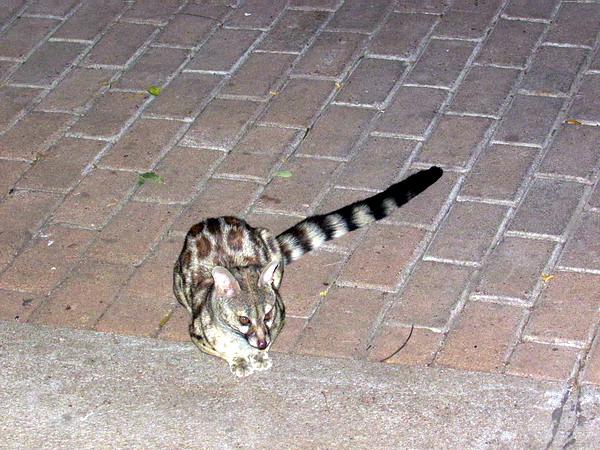 © Bushcraft
© Bushcraft
Talamati
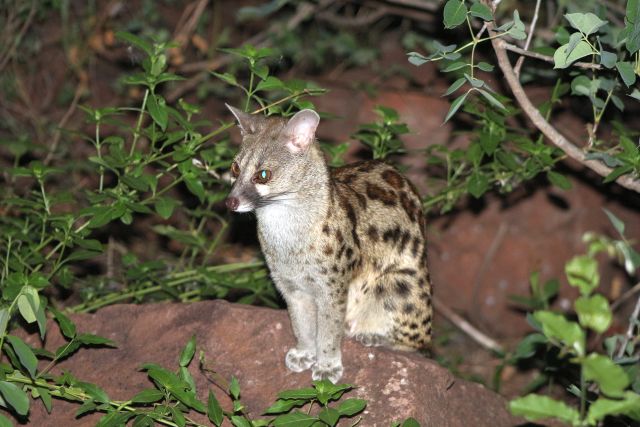 © Alf
© Alf
Mopani
Talamati
 © Alf
© AlfMopani
Pumbaa wrote: ↑Thu Apr 19, 2018 9:08 pm Back in our bungalow [Berg en Dal] Timon lit the braai and we made ourselves comfortable already around the table with our books and the minute our steaks were ready the incidents precipitated.....
We were still busy with our meat when we heard a rustling in the tree close to our bungalow and when we looked up we saw a genet who jumped from the tree top on to our roof and there started to poo
and because of the roof was steep the droppings started to roll down the roof and landed right on our table but gladly neither on our plates nor in our glasses but in fact we had a good laugh at that incident already. Whilst Timon was busy in pursuing the genet
I was searching for a torch as Timon mentioned something about a loud hissing but we could not believe that such a small cat can hiss that loud and so whilst shining with our torch into the direction we first got an extreme shock as we noticed a large black mamba extreme close to our bungalow
and both the genet and the black mamba obviously hissed at each other
aat wrote: ↑Sun Dec 14, 2014 12:48 am
Trip to Kruger NP from November 11th till December 4th 2014
After Satara we went to Mopani for 6 nights.
Mopani is my place… I just love it. It’s nice, friendly people, quiet and like Satara we always ask for the same “bungalow” and without any problem we always get that one.
Guess what… first night and Braai time…. And we got another lovely guest.
After the AWC now we had fun with this Genet cat
The Genet visited us almost every night…. Feeling home again here !
-
Klipspringer
- Global Moderator
- Posts: 5858
- Joined: Sat Sep 14, 2013 12:34 pm
- Country: Germany
- Contact:
Re: Genets (Genetta spp) in Southern Africa
South African Small-spotted Genet / Feline Genet Genetta felina
or Small-spotted Genet Genetta genetta
COMMON NAMES
Small-spotted Genet, Common Genet or South African small-spotted Genet and Feline Genet.
The English names for this species are South African small-spotted Genet and Feline Genet. The former is less appropriate than the "Southern" version chosen here since this "species" is present in Namibia and southern Angola too. However, studies have shown that genetic variation within the "Northern" small-spotted genet clade is so high that we likely have there several species. Therefore, "Feline genet" might be the most appropriate English name in the future, and it would already be nowadays, as used for example in the Handbook of the Mammals of the World, Vol. 1, Carnivores (2009).
TAXONOMIC NOTES
There is a high degree of phenotypic variation in this species which resulted in the description of several subspecies; the validity of many of these
remains untested, while others may actually represent distinct subspecies or even species (Gaubert et al. 2004, 2005, 2009). A recent mtDNA-based study suggested at least four distinct geographic lineages within the species circumscribed to the Mediterranean Basin, western Africa (also spread into North Africa), southern Africa and the Arabian Peninsula (Gaubert et al. 2011). The taxonomic status of Genetta felina, a lineage endemic to southern Africa, remains debated (see Gaubert et al. 2004, 2005; Gaubert & Begg 2007).
Genetic and morphometric analyses have shown that "felina" individuals differ from other G. genetta subspecies. For now regarded as a different species, but other genetic markers or genomic analyses are needed to evaluate the overall % differentiation. Threshold accepted for species level is blurry and varies from taxon to taxon. Genetta felina may be downgraded to subspecies in the future.
Note that individuals from southern Africa notably differ from their European and other African congeners by the presence of conspicuous “black socks”, i.e. the coloration of the whole hindfoot and that of the posterior part of the forefoot is completely dark.
RANGE DESCRIPTION
In South Africa, the Small-spotted Genet is common in the Eastern, Northern and Western Cape provinces, parts of KwaZuluNatal, and in the Free State Province. But it occurs all over South Africa and also in Namibia, Botswana and southern Zimbabwe.
Protected areas: Kgalagadi Transfrontier Park, Kruger National Park
Sympatric species: Small-spotted Genet occurs in sympatry with Cape Genet (Genetta tigrina) and Rusty-spotted G. maculata.
HABITAT AND ECOLOGY
Small-spotted Genets are found in a large variety of habitats.
Small-spotted Genets feed mainly on small mammals, but will also take birds, other small vertebrates, insects and fruits.
In South Africa, radio-tracked genets were crepuscular, starting activity on average around 18h00 (but as early as 16h30) and ceasing around 04h00 (but as late as 07h20). Genets were active between 5 and 13 hours and travelled over 1.7–7.9 km per night, depending on the sex and season.
Small-spotted Genets are solitary but may form pairs during the breeding season. They are territorial, with male home ranges including that of several females but no other adult males, and adult female home ranges do not overlap.
Similar to what is observed in other genet species, intraspecific communication is mainly done through olfaction, notably with scats deposited at conspicuous latrines. These are usually strategically located in the animals’ home range boundaries, such as large tree branches and high rocks.
IDENTIFICATION
The typical "felina" phenotype from Southern Africa has a greyish-ashy background color.
Small to medium-sized spots
White eye brows (quite strongly marked in small-spotted genet)
Erectile dorsal crest (The only genet in Southern Africa with a huge dorsal crest is the small-spotted genet)
"Black socks" = black legs, at the front legs, this is mostly the hind part of the feet which is dark, while the front part is generally grey. Legs also tend to be much darker than in G. tigrina.
9-11 black rings on the tail (maximum 9 in Cape genet)
Dark and light ring hairs overlapping between rings (one can see black hair within the white rings and overall giving the impression that the rings overlap each other).
Very thick (fluffy) tail (when the genet gets frightened)
White rings broader than black rings.
White tail tip (mostly white-white).
Rusty morph of G. felina
It has rusty spots but a black dorsal crest typical of the small-spotted genet. Individuals with a rusty tinge often have yellow (instead of fully white) background colour, and this is also the case on the tail. But the tail is otherwise typical, with overlapping black and white hair.
It seems that the rusty morph is dominant in the Kruger National Park.
Links:
https://www.ewt.org.za/wp-content/uploa ... tta_LC.pdf
or Small-spotted Genet Genetta genetta
COMMON NAMES
Small-spotted Genet, Common Genet or South African small-spotted Genet and Feline Genet.
The English names for this species are South African small-spotted Genet and Feline Genet. The former is less appropriate than the "Southern" version chosen here since this "species" is present in Namibia and southern Angola too. However, studies have shown that genetic variation within the "Northern" small-spotted genet clade is so high that we likely have there several species. Therefore, "Feline genet" might be the most appropriate English name in the future, and it would already be nowadays, as used for example in the Handbook of the Mammals of the World, Vol. 1, Carnivores (2009).
TAXONOMIC NOTES
There is a high degree of phenotypic variation in this species which resulted in the description of several subspecies; the validity of many of these
remains untested, while others may actually represent distinct subspecies or even species (Gaubert et al. 2004, 2005, 2009). A recent mtDNA-based study suggested at least four distinct geographic lineages within the species circumscribed to the Mediterranean Basin, western Africa (also spread into North Africa), southern Africa and the Arabian Peninsula (Gaubert et al. 2011). The taxonomic status of Genetta felina, a lineage endemic to southern Africa, remains debated (see Gaubert et al. 2004, 2005; Gaubert & Begg 2007).
Genetic and morphometric analyses have shown that "felina" individuals differ from other G. genetta subspecies. For now regarded as a different species, but other genetic markers or genomic analyses are needed to evaluate the overall % differentiation. Threshold accepted for species level is blurry and varies from taxon to taxon. Genetta felina may be downgraded to subspecies in the future.
Note that individuals from southern Africa notably differ from their European and other African congeners by the presence of conspicuous “black socks”, i.e. the coloration of the whole hindfoot and that of the posterior part of the forefoot is completely dark.
RANGE DESCRIPTION
In South Africa, the Small-spotted Genet is common in the Eastern, Northern and Western Cape provinces, parts of KwaZuluNatal, and in the Free State Province. But it occurs all over South Africa and also in Namibia, Botswana and southern Zimbabwe.
Protected areas: Kgalagadi Transfrontier Park, Kruger National Park
Sympatric species: Small-spotted Genet occurs in sympatry with Cape Genet (Genetta tigrina) and Rusty-spotted G. maculata.
HABITAT AND ECOLOGY
Small-spotted Genets are found in a large variety of habitats.
Small-spotted Genets feed mainly on small mammals, but will also take birds, other small vertebrates, insects and fruits.
In South Africa, radio-tracked genets were crepuscular, starting activity on average around 18h00 (but as early as 16h30) and ceasing around 04h00 (but as late as 07h20). Genets were active between 5 and 13 hours and travelled over 1.7–7.9 km per night, depending on the sex and season.
Small-spotted Genets are solitary but may form pairs during the breeding season. They are territorial, with male home ranges including that of several females but no other adult males, and adult female home ranges do not overlap.
Similar to what is observed in other genet species, intraspecific communication is mainly done through olfaction, notably with scats deposited at conspicuous latrines. These are usually strategically located in the animals’ home range boundaries, such as large tree branches and high rocks.
IDENTIFICATION
The typical "felina" phenotype from Southern Africa has a greyish-ashy background color.
Small to medium-sized spots
White eye brows (quite strongly marked in small-spotted genet)
Erectile dorsal crest (The only genet in Southern Africa with a huge dorsal crest is the small-spotted genet)
"Black socks" = black legs, at the front legs, this is mostly the hind part of the feet which is dark, while the front part is generally grey. Legs also tend to be much darker than in G. tigrina.
9-11 black rings on the tail (maximum 9 in Cape genet)
Dark and light ring hairs overlapping between rings (one can see black hair within the white rings and overall giving the impression that the rings overlap each other).
Very thick (fluffy) tail (when the genet gets frightened)
White rings broader than black rings.
White tail tip (mostly white-white).
Rusty morph of G. felina
It has rusty spots but a black dorsal crest typical of the small-spotted genet. Individuals with a rusty tinge often have yellow (instead of fully white) background colour, and this is also the case on the tail. But the tail is otherwise typical, with overlapping black and white hair.
It seems that the rusty morph is dominant in the Kruger National Park.
Links:
https://www.ewt.org.za/wp-content/uploa ... tta_LC.pdf
-
Klipspringer
- Global Moderator
- Posts: 5858
- Joined: Sat Sep 14, 2013 12:34 pm
- Country: Germany
- Contact:
Re: Genets (Genetta spp) in Southern Africa
The Kingdon Field Guide to African Mammals: Second Edition (2015) has two species of small-spotted genets for Southern Africa:
Classification and identification according to:
Gaubert, P., Taylor, P. J., & Veron, G. (2005). Integrative taxonomy and phylogenetic systematics of the genets (Carnivora, Viverridae, Genetta): a new classification of the most speciose carnivoran genus in Africa.
Genetta felina South African small-spotted genet
Full dark, continuous mid-dorsal line, always black
Ground color whitish grey (brighter than in G. genetta)
Hair long, presence of a dorsal crest
Posterior parts of feet dark, with hind feet almost completely dark
Confused annulation pattern at beginning of tail (contrary to G. genetta)
Alternation of dark and bright rings to end of tail
Width of bright rings relative to dark rings (middle of tail) = 200%
Tip of tail bright (larger than in G. genetta)
Genetta genetta Common small-spotted genet
Full dark, continuous mid-dorsal line, always black
Hair long, presence of a dorsal crest
Posterior parts of feet dark – central depression of forefeet hairy
Alternation of dark and bright rings to end of tail
Width of bright rings relative to dark rings (middle of tail) = 100%
Tip of tail bright
https://www.researchgate.net/publicatio ... _in_Africa
Classification and identification according to:
Gaubert, P., Taylor, P. J., & Veron, G. (2005). Integrative taxonomy and phylogenetic systematics of the genets (Carnivora, Viverridae, Genetta): a new classification of the most speciose carnivoran genus in Africa.
Genetta felina South African small-spotted genet
Full dark, continuous mid-dorsal line, always black
Ground color whitish grey (brighter than in G. genetta)
Hair long, presence of a dorsal crest
Posterior parts of feet dark, with hind feet almost completely dark
Confused annulation pattern at beginning of tail (contrary to G. genetta)
Alternation of dark and bright rings to end of tail
Width of bright rings relative to dark rings (middle of tail) = 200%
Tip of tail bright (larger than in G. genetta)
Genetta genetta Common small-spotted genet
Full dark, continuous mid-dorsal line, always black
Hair long, presence of a dorsal crest
Posterior parts of feet dark – central depression of forefeet hairy
Alternation of dark and bright rings to end of tail
Width of bright rings relative to dark rings (middle of tail) = 100%
Tip of tail bright
https://www.researchgate.net/publicatio ... _in_Africa




